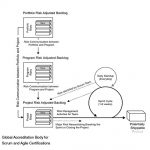Risk is defined as an uncertain event that can affect the objectives of a project and may contribute to its success or failure. Risks with a potential for positive impact on the project are called opportunities, whereas threats are risks that could negatively impact a project. Managing risk must be done proactively, and it is an iterative process that should begin at project inception and continue throughout the life of the project. The process of managing risk should follow some standardized steps to ensure that risks are identified, evaluated, and a proper course of action is determined and acted upon accordingly.
Risk Management consists of five steps:
- Risk identification: Using various techniques to identify all potential risks.
- Risk assessment: Evaluating and estimating the identified risks.
- Risk prioritization: Prioritizing risk to be included in the Prioritized Product Backlog.
- Risk mitigation: Developing an appropriate strategy to deal with the risk.
- Risk communication: Communicating the findings from the first four steps to the appropriate stakeholders and determining their perception regarding the uncertain events.
Risk identification involves the Scrum Team members who attempt to identify all risks that could potentially impact the project. Only by looking at the project from different perspectives, using a variety of techniques, can they do this job thoroughly.
Risk assessment helps in understanding the potential impact of a risk, how likely it is to occur, and when the risk could materialize. The overall effect on business value should be estimated; if that impact is significant enough to outweigh the business justification, a decision must be made whether to continue the project. The assessment of risks is done with regard to probability, proximity, and impact. Probability of risks refers to the likelihood of the risks occurring, whereas proximity refers to when the risk might occur. Impact refers to the probable effect of the risks on the project or the organization. To estimate the probability of a risks, various techniques may be used, including Probability Trees, Pareto Analysis, and a Probability and Impact Matrix. In addition to probability, risk assessment also evaluates the potential net effect of risks on the project or organization. These effects can be estimated using techniques such as Risk Models and Expected Monetary Value.
Under the risk prioritization step, Identified Risks are captured in a Prioritized Product Backlog—so a Prioritized Product Backlog could also be referred to as a Risk Adjusted Prioritized Product Backlog. The prioritized User Stories from the existing Prioritized Product Backlog and the prioritized list of risks are then combined to create an updated Prioritized Product Backlog which includes the Identified Risks.
Risk mitigation can beproactive or reactive. In the case of a risk, a plan B may be formulated, which can be used as a fall-back in case the risk materializes—such a plan B is a reactive response. Sometimes risks are accepted and are an example of a risk response which is neither proactive nor reactive. Risks are accepted because of various reasons, as in a situation where the probability or impact of the risk is too low for a response. Acceptance can also be the case in a situation where the apprehension of secondary risks may deter the product owner from taking any action. The effort made by the Product Owner to reduce the probability or impact—or both—of the risk is an example of a proactive response to mitigating risks.
Risk communication is important because stakeholders have an interest in the project and need to know the hindrances that the project may face. Information provided to stakeholders related to risk should include potential impact and the plans for responding to each risk. This communication is on-going and should occur in parallel with the four sequential steps discussed thus far—risk identification, assessment, prioritization and mitigation. The Scrum Team may also discuss specific risks related to their Tasks with the Scrum Master during Daily Standup Meetings. The Product Owner is responsible for the prioritization of risks and for communicating the prioritized list to the Scrum Team.










